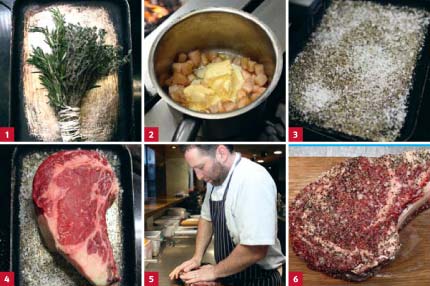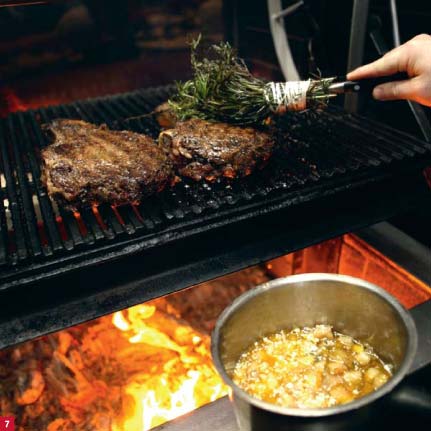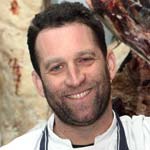Masterclass – Adam Perry Lang's Barbecoa rib of beef
Adam Perry Lang describes the cuts of meat and the slow-grilling methods he uses at Barbecoa, the restaurant he recently opened near St Paul's in London with Jamie Oliver. Michael Raffael reports
Adam Perry Lang describes the cuts of meat and the slow-grilling methods he uses at Barbecoa, the restaurant he recently opened near St Paul's in London with Jamie Oliver. Michael Raffael reports
When I get my chefs to cook on the grill, I find the girls are better at it at first. The men are in too much of a hurry." Adam Perry Lang's comment goes to the heart of his approach to grilling: not fast and furious. Patience, he would argue, is more than a virtue. It's essential.
Two things are going on when a steak hits the grill. On the outside, its surface starts to brown. This is the Maillard reaction we all know about, which makes grilled meat so tasty. On the inside the meat, mostly moisture, heats more slowly. If the exterior broils too fast, it dries out before the inside is done.
The slow-roasting technique has long since proved that chefs can, figuratively speaking, have their cake and eat it: a browned, caramelised surface on a joint and inside it, juicy evenly cooked meat that hasn't dried out or shrivelled at the edges.
At Barbecoa, Perry Lang has extended the principle to the grill. He lets the inside of a piece of beef heat through, then he gives it a final blast over a hotter flame. The method isn't too different from cooking a belly of pork, say, in a water bath and then flashing it in a pan or hot oven to crisp.
Barbecoa buys whole beef carcasses and primal cuts from a combination of co-operatives and individual farmers. Perry Lang doesn't use the EU five-point grading system (EUROP) based on conformation and finish as the be all and end all; he ascribes to animal welfare, traceability, and most importantly, knows who is handling the beef from source throughout its journey.
The restaurant doesn't stick exclusively to a single breed or cross-breed such as Angus, Hereford or Charolais. Age has a bearing - it must be 18-24 months or more - but it's not the determining factor. The weight per side isn't standardised.
Marbling in the lean meat and a large eye muscle are useful pointers to beef that has good texture, taste and yield, provided that they are used with other quality factors. A good fat cover, 2-3cm over the loin, protects meat against dehydration.
Carcasses, planned for upscale restaurants, age for a minimum of three weeks at 1°C, with 85% humidity as a general rule. Barbecoa hangs its meat for around six weeks as a standard - sometimes longer.
FORERIBS AND WING RIBS
At Barbecoa butchers work with a six (or seven) bone joint combining wing ribs and foreribs. Before preparing the ribs, smell the joint at the angle of the vertebrae and the ribs. It should have a pleasant ‘mushroomy' and ‘beefy' aroma and no hint of rancidity.
The three to four bone foreribs are cut from the forequarter. The three bone wing ribs are at the wing end of the loin on the hindquarter. Both will have about 7cm of flank attached to the ribs. A trimmed rib weighs about 750g and is 6-7cm thick.
Prepare the ribs one at a time. Cut down through the meat to the point where the rib slots into the backbone. Saw through the backbone. Saw across the chine. Keeping the knife edge close to the bone, remove the backbone.
Trim the fat cover over the muscle. Don't waste it. Chop it and either render it or use it in burgers and sausages.
Grilling/barbecuing EQUIPMENT
Barbecoa essentially uses a cast iron grill over a fire-pit. The chef uses a wheel to raise and lower it to control the temperature at which the rib broils.
The heat source is a combination of charcoal and hard wood - oak mainly, and residual ashes. The charcoal provides the basic heat and the wood is added for its aromatic input.
The wood has a flame point of 300°C. How soon it reaches this temperature depends on the moisture it contains. Perry Lang dusts the wood with old ashes so that it will help smoke the meat and temper the flames.
Perry Lang's cooking technique (see the recipe on page 46) will be counter-intuitive to chefs who have been taught to "seal in the juices". Its object is to bring the meat slowly to the desired core temperature without developing too much crust and then to finish it with a final blast of heat.
anatomy of a barbecoa rib
In the Barbecoa beef rib you'll see four muscles: the rib eye that helps the animal flex its spine along with a secondary muscle lying against the backbone that also supports the back, the flank muscle which helps cattle breathe and a small nugget (known as the "deckle" in the USA) which has a similar role.
rib of beef (serves two)
Ingredients
1 x 900g prepared rib of beef
20 garlic cloves, peeled
120g unsalted butter
1tbs olive oil
2tbs butcher's grind black pepper
Maldon sea salt
Method
For basting, make a rosemary and thyme brush by tying sprigs to a roasting fork (1).
Melt the butter in a pan with the olive oil and the garlic cloves (2).
Spread the pepper and salt on a small tray (3). Lay the beef on it and press down so the seasoning sticks to the surface (4 & 5). Turn the meat over and do the same on the other side so it's evenly coated (6).
Adam Perry Lang describes the first stage of grilling as "tempering". The grill itself has to be far enough away from the heat source to prevent the meat from searing or caramelising too quickly (at Barbecoa it's roughly 60cm from the wood and charcoal).
Moisten the surface of the beef very slightly and place it on the grill. After a minute or so, turn it over. Dip the herb brush in the garlic butter and baste it slightly - this improves heat transfer.
To improve the smoky flavour, add a small log of wood to the fire and cover it with ashes.
Continue basting and turning the beef until its core temperature meat reaches about 40°C. Then remove it from the heat and let it rest for five minutes.
Lower the grill so it's closer to the fire and let the grill rods heat up.
Put the meat back on the grill to finish cooking. Continue to baste it, but allow the crust to form (7). Don't worry about the classic criss-cross marking.
Take the beef off the grill, sprinkle with fleur de sel and rest again.
As a rough guide to the level of cooking, 45° C is very rare, and 70° is very well done with almost no trace of blood.
Adam Perry Lang's Board dressing
Ingredients
3tbs extra virgin olive oil
1 handful fresh basil leaves
Rosemary/thyme basting brush
Salt and pepper
Moderately hot fresh chilli (optional)
Method
Spread the oil on a wooden carving board (8). Add bruised and chopped basil, the other seasonings and optional grated chilli (9). Mix them together.
Put the grilled rib on the board and carve thick slices. The direction isn't critical (10). Coat both sides of each slice in the dressing (11 & 12).
Either serve the meat on a wooden board or on a serving dish with the juices around it (13).
At Barbecoa, the bone is also served for less self-conscious diners to gnaw.
BEEF RIB ON THE BARBECOA MENU
Barbecoa's theme is flame cookery and its kitchen includes several different types of prime cooking equipment, from tandoor and pizza ovens to the Argentinean grill used for the beef rib. It's served as a special priced at £60 for two. During a busy service of 250 covers, Perry Lang expects to sell upwards of 12. The Smithfield price for foreribs is around £5.80 per kg, but he buys directly from farms and co-operatives. He has to bear the extra costs of extended ‘old-school' hanging, which means a more than average amount of dehydration and excessive trims.
TRICKS OF THE TRADE
â- Don't waste fat; it traps the essential beef flavour
â- Only burn hard woods
â- Scrub the grill with a wire brush during service for better performance
â- Butcher's grind black pepper has a good texture and is less coarse than crushed mignonette
â- Spiking well-hung beef with a fork to turn it on the grill won't cause leeching
â- Keep old BBQ ashes and add them back to the fire for a more smoky aroma ADAM PERRY LANG
He spent four years working with Daniel Boulud at Daniel in New York before moving on to Chanterelle (now closed) in New York as a sous chef. He had spells at Guy Savoy in Paris and with Marc Meneau at L'Espérance in Vézelay. Perry Lang went on to open Daisy May's restaurant in Manhattan, which won Zagat's top BBQ award four years running from 2005. He also has a second partner in Mario Batali, a US TV chef and restaurant icon, at Carne Vino in Las Vegas.
Since the Barbecoa planning stages, Perry Lang has based himself and his family in London. Although he has a 28-strong brigade, divided into split shifts cooking for a 200-seater restaurant that operates seven days a week, he's happiest, he says, when he's at the stove.
Photography by Lisa Barber (www.lisabarber.co.uk)















